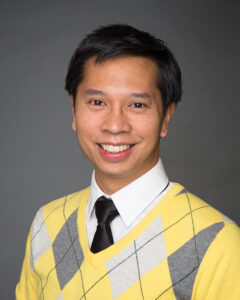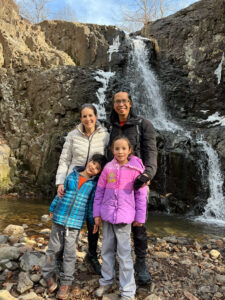This article originally appeared in the Winter 2024 issue of the Gaynor Gazette.
 Though he initially aimed to become an engineer, Science Specialist Andrew Prasarn fell in love with teaching while at Gaynor, with his lessons highlighting the importance of teaching the students how things work so they can create a better future. You can find Andrew not only in the classroom, but also on the court! As a coach for Gaynor’s soccer and boys’ basketball teams, he encourages students to always play their best, while staying close as a team.
Though he initially aimed to become an engineer, Science Specialist Andrew Prasarn fell in love with teaching while at Gaynor, with his lessons highlighting the importance of teaching the students how things work so they can create a better future. You can find Andrew not only in the classroom, but also on the court! As a coach for Gaynor’s soccer and boys’ basketball teams, he encourages students to always play their best, while staying close as a team.
We sat down with Andrew for the latest installment of our “Five Questions With…” series, to learn more about his journey to Gaynor, and the ways he continues his passion for science outside of the classroom.
1. What was your journey into teaching like, and how did you find yourself at Gaynor?
My journey to teaching was unexpected, and a little serendipitous. I grew up loving math and science, and I went to college for mechanical engineering at Stevens Institute of Technology in 1999. Once I graduated, I saw there was an opening at Liberty Science Center for a teaching position, what was called a “Science Demonstrator.” It was much more informal education, but the skills you needed included being out there on the museum floor, where strangers would come up to you, and you would have to engage them immediately and start teaching them science, so you really had to make fast connections and think quickly on your feet, which is perfectly what teaching is. We also did programs where we would travel to schools in the area, so I had been in dozens if not hundreds of schools, seeing every type of student that’s out there. I made a good network of friends at Liberty Science Center, I met my wife there, and I also met Christina Fabricant, who is Gaynor’s Science Chair, there. After ten years at Liberty Science Center, Christina talked to me and let me know Gaynor had an opening in the science department for a teaching position, even though she knew I didn’t think of myself as a science teacher at the time. But she encouraged me to try it, and I think it was the best decision. I can’t imagine a better home; it ticks so many of the boxes of what makes me happy and how I can grow in my career, the commute is the only hard part. [laugh] Which is okay, because I love living in New Jersey.
 2. What led you to decide to be a science specialist?
2. What led you to decide to be a science specialist?
I always loved science. I was fascinated by it, I was curious about it, but the thing about teaching science is that everybody is experiencing the natural world, and science is explaining the natural world. I think science is also empowering, because understanding how something works gives you better skills to handle it. Even with just the weather, when they say high pressure front, low pressure front, knowing what that means impacts you, and you can say “Oh okay, I understand what to expect,” without someone just telling you. I really do think it’s important, not only in a practical sense but if you’re thinking about the future, students need to have this base of knowledge to make informed decisions to keep us on a good path.
3. Do you have a favorite science experiment or project?
I have a couple, but one of my favorites is the StarLab, which I love teaching in. I used to love that program when I taught it at Liberty Science Center, and I think it’s one of those that you can’t replicate in any manner, not in a textbook or on a website; not much else can really simulate the night sky like it can. I tell my students that the StarLab is how I learned to find constellations and I can apply that information when I go outside and see the constellations, and so just to have the StarLab as a tool is a great experience. I really like projects that tie in experience with information, with a little bit of the unexpected to keep the students kind of on their toes and show them that science can be not what you expect it to be. [For more on the StarLab, click here.]
4. What do you do when you’re not at Gaynor?
I try to spend as much time as I can with my family, since it’s a long commute on top of the long days I have due to after school and coaching, and when I get home I really want to try to spend as much time with them. I have two kids, seven and ten, and my wife.  We like nature and hiking, and actually my wife and I started a local hiking group with kids and families from our area. So we’ll post on our little hiking club and gather some people to go to trails and help get people out to experience nature, since we all can get cooped up a lot. In terms of my own hobbies, I like to tinker, it’s the engineering part of me. I like to work on cars doing maintenance, and a lot of bikes and electronics; anything that’s broken I like to take it apart and try to revive it or pass it off to someone else. I think our society can be so disposable, no one has the knowledge or initiative to repair things anymore, and it takes a lot of time, but I like that sort of thing so my garage is full of projects. I’m always trying to understand how things work, how the world works, and learning new things about science and technology. I practice what I preach, as I tell the kids.
We like nature and hiking, and actually my wife and I started a local hiking group with kids and families from our area. So we’ll post on our little hiking club and gather some people to go to trails and help get people out to experience nature, since we all can get cooped up a lot. In terms of my own hobbies, I like to tinker, it’s the engineering part of me. I like to work on cars doing maintenance, and a lot of bikes and electronics; anything that’s broken I like to take it apart and try to revive it or pass it off to someone else. I think our society can be so disposable, no one has the knowledge or initiative to repair things anymore, and it takes a lot of time, but I like that sort of thing so my garage is full of projects. I’m always trying to understand how things work, how the world works, and learning new things about science and technology. I practice what I preach, as I tell the kids.
5. Do you have a favorite student story?
I remember a story from several years ago, when we were doing Newton’s First Law. Newton’s First Law is objects in motion stay in motion, objects at rest stay at rest unless they are acted on by a force. And the way we did this is with the magician trick, where you put things on a table on top of a tablecloth, and you pull the tablecloth out from underneath them. It shows [the law] because you are applying the force to the tablecloth, and all the items on top of it have resistance, they want to stay where they are. So if you do it properly, you can pull the tablecloth out and everything stays in place. We actually like to have the students do this, so it’s not just a demonstration, and they experience the results firsthand. I had this one student who was convinced it was not going to work, it was going to be disastrous. And he’s looking at the setup, he’s holding the tablecloth, and he has so much doubt, he’s saying, “If I pull this towards me, it’s all going to come flying at me, and hit me in the face!” And I told him no, you gotta trust science. So he yanks it off, and it goes perfectly! Nothing flew at him, everything stayed perfectly exactly where it was, and the expression on his face… [laughing], his jaw was hanging open and he was like “What?” I thought that was the perfect blend of what we’re always looking for, that “aha moment.” This student didn’t think this was possible, didn’t think he could do it even if it was, and he just proved to himself that he could do it, and that it does work, so I think I love that story as an encapsulation of everything we’re trying to do in science.
